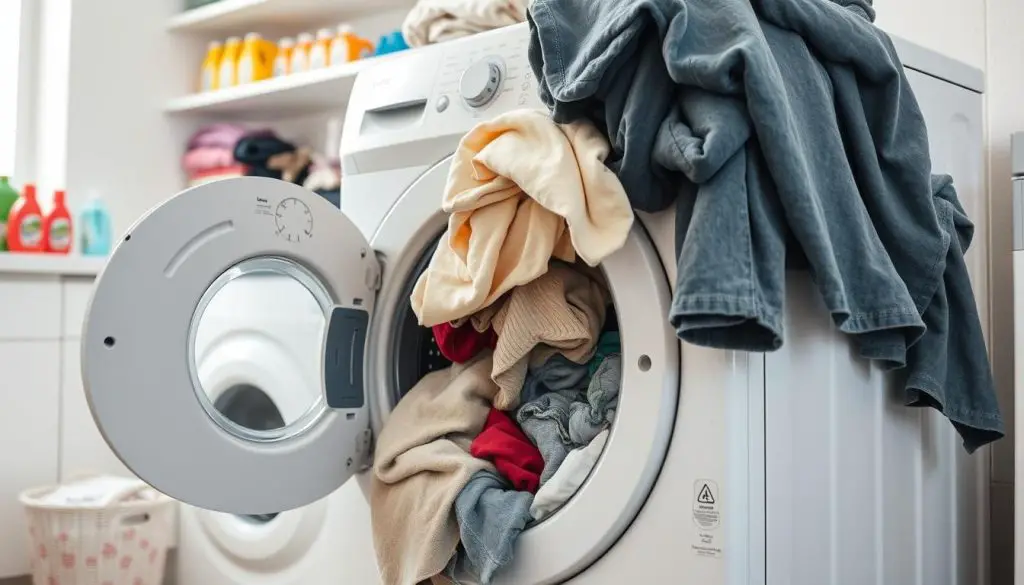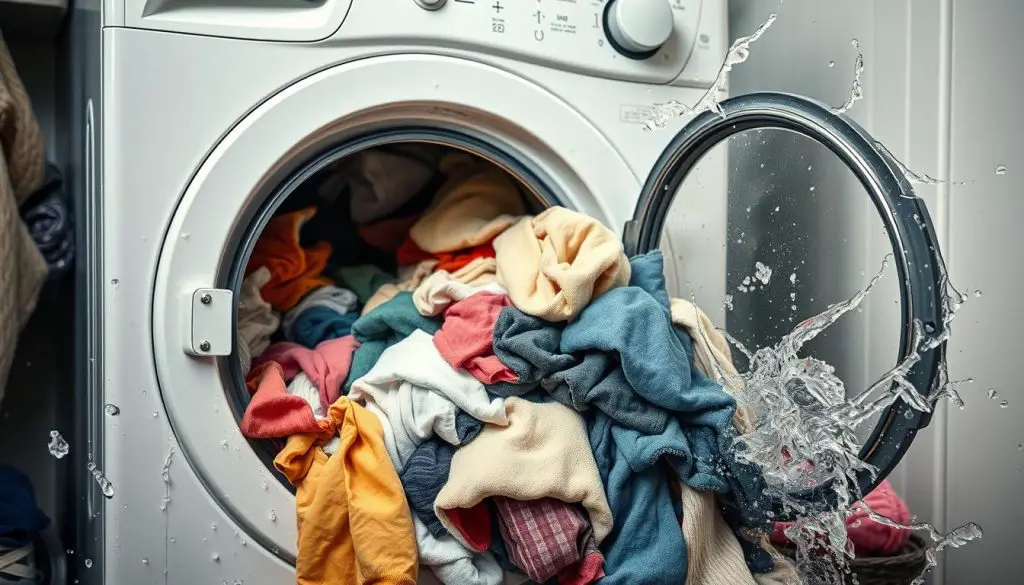Many of us overload our washers to save time and energy. But, this can be risky. Too much in the drum means clothes might not get clean and can damage the washer.
Studies show that overloading can harm parts like seals, bearings, and the motor. This can lead to expensive repairs or even needing a new washer.
Knowing the dangers of overloading can save us money and keep our washers working right. Overloading can cause dirty clothes and mechanical problems.
We’ll look into how overloading affects our washers and how to keep them in good shape.
Table of Contents

Washing Machine Load Limits
Every washing machine has a specific laundry load capacity. You can find this in the owner’s manual or on the machine. Most machines can handle between 6 to 10kg of laundry. It’s key to know these limits for the best performance.
A 7kg washing machine can fit about 35 T-shirts. An 8kg model can hold around 40 T-shirts. These sizes are good for medium-sized homes. For smaller homes, a 6kg washer is enough for 1-2 people. Larger homes might need washers over 10kg.
| Drum Size | Load Capacity | Suggested Items |
|---|---|---|
| 6kg | 5 hand towels, 6 T-shirts, 2 pairs of jeans, 1 jumper, 10 pairs of socks or underwear, 2 bed sheets | |
| 7kg | 5 hand towels, 10 T-shirts, 4 pairs of jeans, 1 jumper, 20 pairs of socks or underwear, 2 bed sheets | |
| 10kg | 8 hand towels, 15 T-shirts, 4 pairs of jeans, 2 jumpers, 30 pairs of socks or underwear, 3 bed sheets |
Knowing these limits is important to avoid overloading washing machine risks. Overloading can mess up the cleaning process. Clothes won’t get clean because they’re too tight together.
Also, overloading can damage your washing machine. It can wear out belts and cause the machine to spin unevenly. This can lead to expensive repairs. Following the manufacturer’s advice helps your machine last longer and keeps your clothes clean.
What Happens When You Overload a Washer?
Overloading a washer can cause many problems for our clothes and the machine itself. Too many clothes in the washer lead to serious cleaning issues. Let’s look at what happens when we do this.
Consequences for Your Clothes
Stuffing too many clothes in the washer stops the machine from working right. It can’t move water and detergent well. This leaves clothes dirty or soiled after washing.
Small items might get lost down the drain, causing plumbing problems. Clothes with zippers or buttons can also damage each other. This can lead to rips or tears, making us spend more money on repairs or replacements.
Impact on Cleaning Efficiency
Overloading a washer makes it clean less effectively. The same amount of water is used, no matter how many clothes are in it. This means clothes aren’t cleaned well, and we need to wash them more times.
This increases our water and energy bills. It also puts too much strain on the washer’s motor and parts. Over time, this can shorten the washer’s life and lead to expensive repairs.
can you break a washer by overloading it
Overloading a washing machine can cause serious problems. It affects both the appliance and our laundry. Ignoring the weight limit set by the manufacturer can lead to washer drum damage and other issues.
When we overload the washer, we put too much stress on important parts. This can cause lasting mechanical damage over time.
Potential for Mechanical Damage
Washing machine overload can harm its efficiency and reliability. The motor works too hard, leading to many mechanical problems. These include:
- Damage to bearings and seals
- Increased wear on the electric motor
- Greater risk of drum failure
- Potential overflow due to valve malfunctions
Ignoring these stresses can shorten our washing machines’ lifespan. This leads to expensive repairs or even needing a new one. Knowing about these risks helps us manage our laundry better.
Signs of Damage to Look Out For
Being aware of damage signs helps us fix problems early. Common indicators of overloading include:
- Clothes that come out dripping wet, despite a full wash cycle
- Excessive noise or vibrations during operation
- Visible wear on laundry, such as holes from sharp attachments like zippers
- Persistent soapy residue on clothing
- Frequent need for repairs, signaling ongoing problems
These signs mean we might be overloading our washer. It’s time to rethink our laundry habits. Making changes can help our machine last longer and keep our clothes clean.
Washing Machine Overload: Risks Involved
Overloading a washing machine can cause short-term and long-term problems. We might think adding more clothes saves time, but it doesn’t. Clothes often don’t get clean, so we need to run extra cycles. This wastes water and energy.
Putting too many clothes in can also damage the machine. Small items like socks might get stuck in the drainage system. This can lead to plumbing issues. Clothes can get damaged too, with zippers and buttons causing holes.
Dryers face similar issues when too full. Clothes may come out damp or dirty, needing more cycles. This wastes resources. Overcrowding also causes uneven drying and wrinkles. Modern sensors can fail if the dryer is too full.

It’s important to leave space in the washing machine and dryer. The 2/3 rule for dryers helps avoid problems. Knowing when a load is too big can prevent damage. By being careful, we keep our machines running well for longer.
Understanding Laundry Load Capacity
Every washing machine has specific manufacturer guidelines for laundry load capacity. Knowing these limits is key to keeping the machine in good shape and getting the best wash results. Most machines can handle loads between 6 to 9 kg. For example, a 9 kg washer can fit up to 45 T-shirts, ensuring great cleaning without overloading.
Manufacturer Guidelines
It’s crucial to follow the manufacturer guidelines to avoid overloading. For the best results, fill the drum half to three-quarters full. Top-load washers usually have less capacity than HE top loaders or front loaders because of their agitator systems. Overloading can cause imbalance, shutdowns, or excessive vibrations.
How to Measure Proper Load Size
To prevent overloading, we can use simple methods. The “one-hand rule” is a good guide: if we can fit our hand in the drum after loading, it’s probably okay. We can also weigh our laundry bags to check if the weight fits within our machine’s capacity.
Proper load size prevents mechanical problems and boosts washing efficiency. By following these tips, we can ensure our washers last longer and work better.
| Washing Machine Capacity (kg) | Number of T-Shirts |
|---|---|
| 6 kg | 30 T-shirts |
| 7 kg | 35 T-shirts |
| 8 kg | 40 T-shirts |
| 9 kg | 45 T-shirts |
Common Symptoms of an Overloaded Washing Machine
Noticing issues with our washing machine often points to overloading. Knowing these signs helps us keep our appliance in good shape. This way, our laundry stays clean and fresh.
Dirty or Soiled Clothes After Washing
Dirty clothes after washing are a clear sign of overloading. If clothes still have soap residue or look dingy, the washer is overloaded. This stops clothes from getting properly washed, wasting water and energy.
We end up re-washing items, which strains our resources. It also wears out our clothes faster.
Excessive Noise and Vibration
Too much noise and vibration during wash cycles mean the machine is overloaded. Sounds like banging or squeaking show the washer is under too much stress. If these sounds happen often, it’s time to rethink how we load the washer.
Overloading too much can damage the machine. This can shorten its life and affect how well it works.

The Cost of Overloading Your Washer
Knowing the cost of overloading a washer is key to saving money and keeping our appliances running well. Overloading can cause many financial problems that add up fast. One big worry is the cost of overloading washer. Ignoring the load limits can make our utility bills go up because the washer uses more water and energy.
Clothes might not get dry, wasting water and energy. This can also lead to higher repair or replacement costs later on.
Financial Implications
Overloading our washing machine can cost us money right away and in the long run. It can wear down parts like bearings and the cylinder shaft, leading to long-term damage repair costs. Each cycle can cause clothes to not get clean properly and can wear out fabrics over time.
This can lead to spending more on utilities and replacing damaged clothes and linens.
Long-Term Damage Repair Costs
As time goes on, problems from overloading can add up, leading to big long-term damage repair costs. Damage to the washer drum and motor can make it hard to keep the appliance working. These failures often need expensive repairs or replacements.
To avoid big financial problems, we should follow the recommended load limits and watch our laundry habits closely.
Best Practices to Avoid Overloading Your Washing Machine
To keep our washing machines running well, we must avoid overloading. It’s key to follow the manufacturer’s guidelines for load sizes. Top-load washers can handle about 12 pounds, while front-load machines can manage up to 18 pounds.
Using the one-hand rule helps us check if there’s enough space in the drum. We should leave at least 6 inches for clothes to move freely. This ensures clothes don’t tangle and puts less strain on the motor.
Keeping a regular cleaning schedule for our machines is also important. We should prepare laundry carefully, like checking pockets and zipping up zippers. By not overloading, we protect our clothes and make our appliances last longer.
FAQ
Can you break a washer by overloading it?
What are the risks of washing machine overload?
How much laundry can I safely put in my washer?
What happens if too many clothes are in the washer?
What signs show that I might be overloading my washer?
Are there financial implications for overloading my washing machine?
How can I measure my laundry load size accurately?
What are best practices to avoid overloading my washing machine?
Related Articles:

